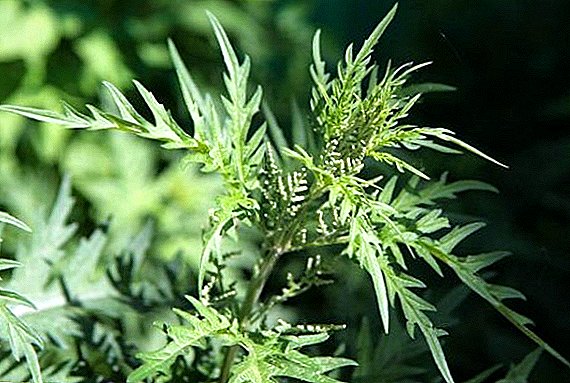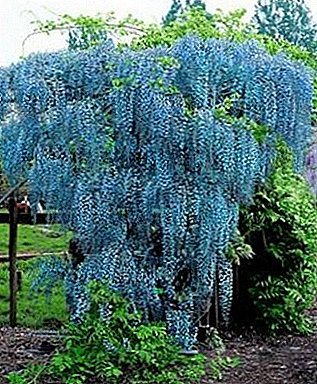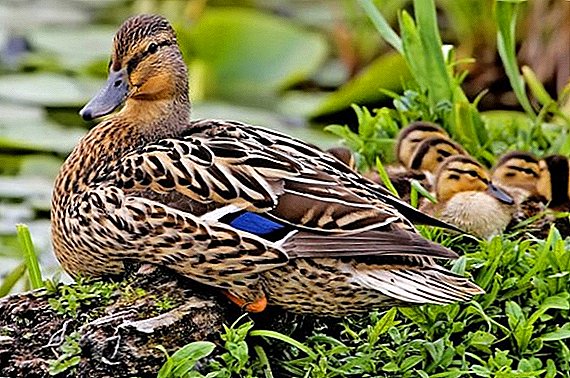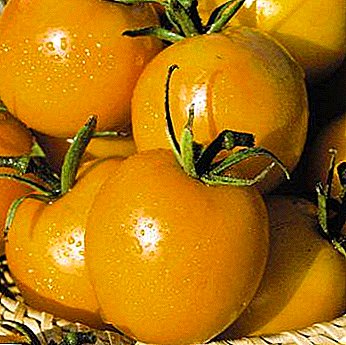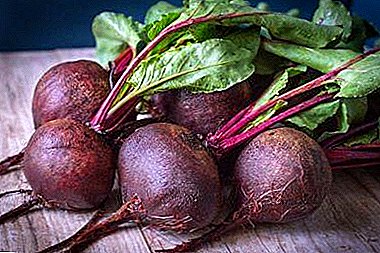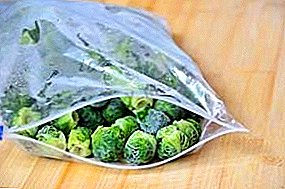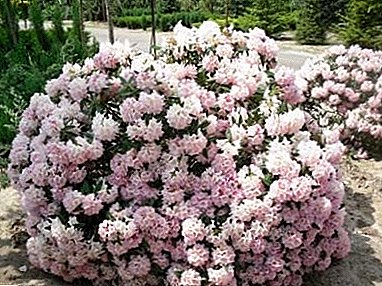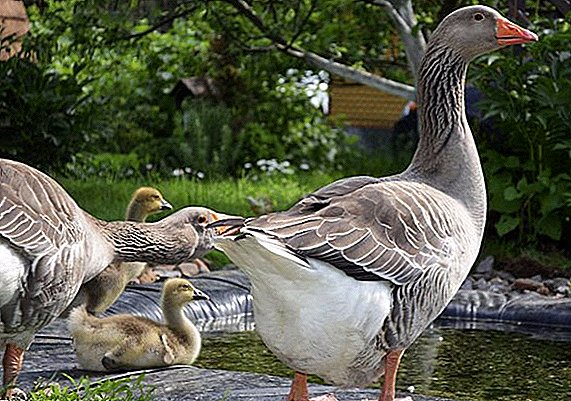 Novice poultry farmers often face the question of choosing a good breed of geese, which would be distinguished by high productivity, unpretentiousness to external factors, and resistance to various diseases. For those who first decided to have these birds, we offer a description of the most common breeds that will allow you to make an intelligent choice.
Novice poultry farmers often face the question of choosing a good breed of geese, which would be distinguished by high productivity, unpretentiousness to external factors, and resistance to various diseases. For those who first decided to have these birds, we offer a description of the most common breeds that will allow you to make an intelligent choice.
Gorky (lindovskaya)
The leader among geese is the Linda geese, which are especially popular in Germany, France, Hungary, the Russian Federation, and Ukraine. Gorky geese have a fairly large size, large weight, oblong body. The distinctive features of the birds are the presence of a "bump" on the forehead, which appears at the end of the 6th - the beginning of the 7th month, and the plumage is white.
Get acquainted with the peculiarities of breeding geese Linda.

Did you know? Gorky breed was grown in the late 90s of the last century in the Nizhny Novgorod region by crossing several species of geese: Chinese, Arzamas, Landsky, etc. In 1994, the breed received the official name - Linda.Among the advantages of birds distinguish:
- large size. On average, the parameters of the body weight of an adult goose are equal to 8 kg. Already 3-4 months after birth, the offspring weighs more than 4 kg;
- fertility. Linda is a beautiful hen, in 5-6 months egg laying begins, for the period of which about 50 eggs weighing up to 170 g are laid. Eggs have excellent properties: high fertility - 90%, viability of chicks during incubation - up to 80%, survival of the young - up to 90%;
- unpretentiousness in nutrition. Representatives of the Lind breed are not picky about food, like green grass or mixed fodder;
- adaptability to harsh climatic conditions, resistance to frost and high temperatures;
- calm, peaceful temper;
- tasty, soft, dietary meat.
 Among the minuses of the breed can be noted:
Among the minuses of the breed can be noted:
- tendency to damage by helminths;
- the need for constant access to water;
- reduced immunity in the offseason.
With the possibility of regular walking of geese, various diseases begin to develop near the water bodies, and the fluff and meat deteriorate.
Kholmogorskaya
Kholmogorskaya can be attributed to meat breeds of geese, popular in the post-Soviet countries. Its representatives have a strong constitution, elongated neck, bulging powerful chest, long wings, white or gray-white color. Kholmogorov can be recognized by its characteristic massive knob on its beak, which grows from half-year-old goslings. The beak and paws of birds are painted orange. Under proper conditions, Kholmogory geese can live up to 17 years.
Their key benefits are:
- unpretentiousness in food. Can eat and feed, and green grass, and animal feed, and other food;
- calm and peaceful nature. Geese do not show aggression, calm, quickly attached to the house;
- excellent resistance to many diseases;
- productivity. The bird quickly gains weight, is a source of tasty, dietary meat, high-quality feather and fluff.
 Also geese need water procedures, so their own artificial reservoir should be organized for them.
Also geese need water procedures, so their own artificial reservoir should be organized for them.Large gray
In the 50s of the last century, a new breed of geese was created - large gray ones, under which it is considered to be: Ukrainian origin - Borkowski, Russian - Steppe Tambov. Birds belong to the category of moderate, have a broad body, a well-defined belly, powerful pectoral muscles, slightly bulging muscles, a compact head, a powerful beak of an orange-red shade. Geese have a gray, dark gray plumage with a white color on the stomach.
Breed is characterized by such advantages:
- good egg-laying performance: in one season the goose can carry up to 60 eggs weighing up to 175 g, while the viability of the clutch reaches up to 70%;
- quick weight gain. Already by 9 weeks the weight of the bird reaches 9.5 kg;
- endurance, active character;
- the ability to do without ponds;
- low dietary requirements.
 The disadvantage of this breed is considered to be a relatively low survival rate of young animals, about 60%. In addition, gray geese are vindictive, they remember the offender for a long time and can even get revenge after a certain time.
The disadvantage of this breed is considered to be a relatively low survival rate of young animals, about 60%. In addition, gray geese are vindictive, they remember the offender for a long time and can even get revenge after a certain time.
For a long time, goose fat has been on the list of useful products that are used in traditional medicine to treat diseases of the respiratory tract.
Toulouse
One of the oldest breeds of geese - Toulouse, bred in France, in Toulouse in the XVII century, by the domestication of wild geese. Toulouse rather large, have a dark gray color, rolling in the lower part in white. The birds have a massive body, a large, strong neck, a compact head with a straight orange beak, short but powerful limbs. Some representatives of the breed grow so-called "wallets" under the jaw and large fat folds in the belly area.
This type of geese has a lot of key advantages:
- Massive, big weight. The average live weight of a gander reaches 8–10 kg, of geese - 6–8 kg. At the age of 8 weeks, the individual grows to 4 kg.
- Rapid growth.
- Unpretentiousness in food.
- High quality feather and down.
- The accumulation of a large fat reservoir.
 At the same time, the Toulouse geese are not very mobile, therefore they are very poorly adapted to pasture type of food, they are sensitive to high humidity parameters and low temperatures, which affects their productive qualities. As for egg-laying, the average indices of females are 25-35 eggs per year weighing up to 190 g. Females are poor chicks, the survival rate of the goslings is only 50-60%.
At the same time, the Toulouse geese are not very mobile, therefore they are very poorly adapted to pasture type of food, they are sensitive to high humidity parameters and low temperatures, which affects their productive qualities. As for egg-laying, the average indices of females are 25-35 eggs per year weighing up to 190 g. Females are poor chicks, the survival rate of the goslings is only 50-60%.
Italian
The Italian breed of birds is popular all over the world due to the extraordinary taste of meat and fatty liver, from which they make an excellent reference foie gras. However, the merits of the Italians do not end there. They have a beautiful appearance, akin to swans, they perfectly adapt to poor climate conditions, they can be kept without reservoirs.
Italian geese are distinguished by a white plumage, a small, compact body, a small head, a short neck and a smooth back. An adult male grows up to 6-7 kg, a female - up to 6 kg. Birds are characterized by excellent reproduction properties: during the laying period, the female is able to lay 40-50 eggs weighing up to 170 g, hatchability equal to 70%. The goose reaches sexual maturity by the 240th day of its life. Italians have a strong, strong-willed and independent character, they never mix with other geese. 
Did you know? The birds were bred in the open spaces of Italy, which is why they got their name. Despite the exquisite taste of poultry meat, it is bred specifically to produce a gourmet liver, which can weigh up to 600-700 g, which is about 7% of the total mass.
Tula fight
Tula fighting geese are extremely mobile, cocky and pugnacious character, have excellent endurance, strength, expressed qualities of a real fighter. They are used both for the purpose of receiving tasty dietary meat, and for the purpose of carrying out fighting fights.
The physiological characteristics of the body and the unique structure of the beak determined the fighting qualities of the bird. She has a strong, powerful body, wide back and deep chest, powerful wings, muscular limbs. The beak is short and hunchbacked, specially created for delivering deadly blows. Color - gray, with clay shades. The body weight of the male varies from 5 to 7 kg, the females - 5-5.5 kg. 
Check out common species of wild geese.
The advantages of the breed are:
- unpretentiousness in care and food;
- endurance, vitality and strong immunity;
- ability to endure frosts, heat.
Important! It is not recommended to keep other breeds of birds with Tula "fighters", since the foolish nature of the former will bring discord to the "collective". Especially dangerous are males who have reached four years of age.
Legart
Legart Danish geese resemble Italian in their exterior properties. Their distinguishing features are considered a more relaxed disposition, friendly character and good earliness. The unique properties of legart are considered:
- absolutely white color without any stains;
- powerful, slightly extended body with an even, strong back;
- high quality down and feathers, tightly pressed to the body;
- straight neck of medium length;
- compact head with a beak orange color without kinks;
- the absence of "bumps" on the head or "wallet" under the jaw.
 With proper diet, a goose can gain weight up to 10 kg, a gander - 9-11 kg. Legarts are not whimsical to the conditions of detention, they are perfectly gaining weight on pasture, they are easily cultivated at home. They are satisfactory hens, laying up to 40 eggs with a conclusion up to 65%. Goslings are strong, physically healthy, have a high percentage of survival and are actively gaining weight.
With proper diet, a goose can gain weight up to 10 kg, a gander - 9-11 kg. Legarts are not whimsical to the conditions of detention, they are perfectly gaining weight on pasture, they are easily cultivated at home. They are satisfactory hens, laying up to 40 eggs with a conclusion up to 65%. Goslings are strong, physically healthy, have a high percentage of survival and are actively gaining weight.It is useful to know when geese start to fly at home.
Chinese
Purebred Chinese geese are difficult to confuse with other species. They have a delicate, elongated and long neck, a large lump on the forehead, an egg-shaped body, proudly raised chest and strong wings with a wide scope. There are two subspecies of "Chinese": gray and white, the differences between them are in color.  The weight of an adult male varies in the range of 5-5.5 kg, females - up to 4 kg. Chinese geese can be pleased with high productivity: the female is able to give 50-70, and sometimes up to 100 eggs weighing 120 g. The hatchability of young stock is 75-80%, of which 99% survive. Also, the birds of this breed are quite hardy, not demanding to the conditions of detention and diet, but are characterized by a foolish, noisy and restless nature.
The weight of an adult male varies in the range of 5-5.5 kg, females - up to 4 kg. Chinese geese can be pleased with high productivity: the female is able to give 50-70, and sometimes up to 100 eggs weighing 120 g. The hatchability of young stock is 75-80%, of which 99% survive. Also, the birds of this breed are quite hardy, not demanding to the conditions of detention and diet, but are characterized by a foolish, noisy and restless nature. 
Kuban
The Kuban geese, grown in the Kuban region by crossing Linda and Chinese birds, acquired wide demand in Ukraine, Russia, Moldova. Despite the fact that the “Kuban” can not boast of large dimensions, they are valued for their high performance. During the period of socks, the female lays up to 90 eggs weighing 140-150 g, in which the safety of the young after incubation is 85%.
Kuban geese are characterized by a raised, elongated body, a large head with a cone in the frontal part, a rounded chest, thick gray-brown plumage with a distinctive dark brown strip on the head and neck.
Geese have good qualities, for which breeders deserve attention:
- good reproducibility;
- excellent hatchability rates;
- adaptation to different weather conditions.
 The breed is not without flaws: a nondescript appearance due to skin color and plumage, slow growth of young animals and an unfriendly, spiteful character.
The breed is not without flaws: a nondescript appearance due to skin color and plumage, slow growth of young animals and an unfriendly, spiteful character.
Landa
At the beginning of the 20th century, a new breed was bred in France - Landskoy, the exterior features of which are: massive navicular torso, broad chest and large head, thick, long neck, bag on the stomach and a unique feather pattern on the wings in the form of scales.
Did you know? Purebred Landa geese are practically not grown. In most cases, Land hussars bred with Italian, Hungarian birds are bred, to get a delicacy - large foie gras weighing up to 800 g.Adult males can reach a mass of up to 8 kg, crossed - up to 10 kg. The females of geese, although they are good chicks, but give a small brood - up to 30 eggs, with a hatchability percentage - 45-50%.
 Land geese appreciate for:
Land geese appreciate for:- the ability to grow a large liver - up to 800 g;
- the possibility of obtaining high-quality pen up to three times a year;
- excellent maternal instinct;
- the bold nature of the gander and their ability to look after the flock.
Shadrinsk
A rather old breed of shadrinsk geese was bred on the territory of the Perm province three hundred years ago. Like all "old-timers", it has a number of drawbacks, among which there are low rates of aesthetics and poor productivity. However, many disadvantages are lost against the background of multiple advantages:
- adaptation to harsh climatic conditions;
- good vitality;
- excellent taste of meat;
- high level of fertilized eggs;
- activity;
- unpretentiousness in food, an opportunity to use all types of grain crops.
 The female is able to lay 25-30 eggs weighing 140-170 g in one cycle. Mature females can reach a weight of 4.5-5 kg, males - 5.5-6.5 kg. At the age of 5 months the weight of the young is over 5 kg.
The female is able to lay 25-30 eggs weighing 140-170 g in one cycle. Mature females can reach a weight of 4.5-5 kg, males - 5.5-6.5 kg. At the age of 5 months the weight of the young is over 5 kg.
Hungarian
The universal breed of geese, representatives of which are excellent for meat, fluff and liver, is considered to be Hungarian, obtained by crossing with geese Landa breed. Hungarian birds are heavyweight, have a massive large but short body, a rounded chest, a smooth back, a massive neck of medium length, short muscular legs, a small head with an orange beak. The weight of an adult male is 6-7 kg, females - 5.5-6 kg.
The breeding of Hungarian geese is interesting for several factors:
- valuable, dietary meat and liver;
- high quality of feathers and down;
- rapid pace of weight gain.
 The hatchability of goslings during incubation is 65-70%, the survival rate of the young is 97%. Among the cons of birds can be noted:
The hatchability of goslings during incubation is 65-70%, the survival rate of the young is 97%. Among the cons of birds can be noted:- negative tolerance of dampness and low temperatures,
- high incidence rate
- short term laying.
Adler
As a result of the crossing of the local gray geese of the Krasnodar Territory with the gray geese of a large breed, a new species of bird was obtained - Adler. The breed is perfectly adapted to the hot climate, differs excellent taste of meat, vitality, unpretentious content.
Geese are medium in size, with a long body, a rather wide powerful chest, not a long neck and small limbs of orange color. The weight of an adult male is 6-7 kg, females - 5-6.5 kg. Geese are characterized by low egg laying - 30-35 units weighing up to 170 g. Fertilization of eggs - 80-90%, the percentage of brood - 60%.  The disadvantages of the breed are determined by the peculiarity of its grandparents - large gray geese. This is a low survival rate for young stock as well as a foolish, restless nature.
The disadvantages of the breed are determined by the peculiarity of its grandparents - large gray geese. This is a low survival rate for young stock as well as a foolish, restless nature.
Arzamas
One of the most highly productive breeds of geese is rightly Arzamas, bred for the selection of dietary meat. Also representatives of this breed were used to participate in the battles.
Arzamas birds have an excellent constitution, which is characterized by a number of unique qualities:
- white, thick plumage;
- beautiful elegant neck;
- small, neat head with an orange beak;
- small limbs;
- large blue eyes;
- flat, flat back.
 Among the advantages of the breed are:
Among the advantages of the breed are:- good health, stamina;
- satisfactory fertility rate;
- resistance to external factors;
- excellent preservation of young.
Vishtinez
Geese Vishtinez differ from others, above all, the structure of the body. They have a small, compact body, a small oval-shaped head, an arched neck, short limbs.
Appreciate the breed for its high meat characteristics. Gander can grow up to 7 kg, goose - up to 6 kg. Already by two months the weight of the goslings is 4 kg. In 10 months the sexual maturity of birds begins. The female for the year is able to give up to 40 eggs weighing 160-170 g. More than half of the eggs are fertilized, 75% survive.
With one carcass you can get 70% of meat, which has an excellent taste - moderately fat and tender. Geese Vishtinez - strong, healthy, perfectly adapted to external conditions, unpretentious in care and undemanding in the diet.
Important! Due to its high physical performance, qualitative and healthy gene pool, this variety of geese is most often used to breed new, more advanced bird species.
Emden
Emden geese, whose birthplace is the small German town of Emden, attract breeders with good health and fast weight gain. Already on the 60th day of its life the bird is gaining more than 4 kg, by the adult period its weight is 10 kg.  The bird does not show any problems with feeding, it tolerates the pasture mode well. The Emden geese have a rather massive body, a thick short neck, a large head with a bright orange beak. A distinctive feature of the breed is the change of plumage. Young geese have a light gray tint, in two months they become thick gray, and already adult individuals differ completely gray or white. The egg-laying of eggs by the female is 35 pieces weighing 180 g.
The bird does not show any problems with feeding, it tolerates the pasture mode well. The Emden geese have a rather massive body, a thick short neck, a large head with a bright orange beak. A distinctive feature of the breed is the change of plumage. Young geese have a light gray tint, in two months they become thick gray, and already adult individuals differ completely gray or white. The egg-laying of eggs by the female is 35 pieces weighing 180 g.
Эмдемские гуси радуют не только вкусным мясом, но и высококачественным пухом и пером.
Узнайте, почему болеют гуси и какие методы их лечения.
Суховская
The Sukhovsky goose, whose birthplace is Slovakia, the town of Suha, today does not have a large geography of distribution and is grown on some European farms. The distinctive anatomical properties of the bird are: long, wide body, large head, powerful neck, medium length, strong straight beak. Geese have a clay color with white inserts on the abdomen and chest.
Sukhovskaya breed refers to moderate birds. Male weight reaches 6.5-7.5 kg, smaller females - 5.5-6.5 kg. Geese have a number of key advantages:
- the value of meat and feathers;
- undemanding of the regime of maintenance and nutrition;
- excellent taste of meat;
- ability to adapt to climate and environment.
 At the same time, sukhovsky birds can not please high egg production - only 14-16 eggs per laying.
At the same time, sukhovsky birds can not please high egg production - only 14-16 eggs per laying.
In the post-Soviet countries, this species is not popular. Often, it is grown in the territory of Slovakia.
Romenskaya
Despite the exotic name of the breed of geese Romenskaya, they are quite ordinary representatives of domestic birds. Birds are a local Ukrainian breed, bred in the Sumy region, in the town of Romny. Externally, the birds of Romene are no different from ordinary large gray geese. They are given only by a different shade of feathering on the neck and the color at the tip of the beak.
Important! In Romenskoy breed the tip of the beak is dark, and at its base there is a small flat of white feathers.The exterior properties of geese are as follows:
- quite mobile, massive body;
- medium long neck;
- wide back;
- large belly with folds of fat;
- small head with a short beak.
 Romensky birds are excellent parents, the female has a highly developed maternal instinct, and the male is an excellent defender. In addition, geese are unpretentious in the diet, do not require special conditions for the content, give high quality dietary meat.
Romensky birds are excellent parents, the female has a highly developed maternal instinct, and the male is an excellent defender. In addition, geese are unpretentious in the diet, do not require special conditions for the content, give high quality dietary meat.Rhine
Thanks to egg production and precociousness, the Germanian geese, the Rhineland, gained wide popularity.
Did you know? For the first time the breed appeared on the territory of Germany in 1940, but did not have much distribution. Only after geese were brought to Hungary 30 years later, they were recognized all over the world.The birds of the Rhine breed have a small body, a compact head with a small orange beak, expressive blue eyes, a medium neck, a broad back and neat limbs.
The meat of the representatives of this species is very tasty, dietary, and the size of the liver affects even experienced breeders, because with normal food it can reach 400 g. The live weight of the male is about 7 kg, the female is easier - 5.5-6 kg. The egg-laying is average - 45-50 eggs per cycle, while the hatchability of offspring is 65-70%. By two months, the weight of the goslings is more than 4 kg.  Due to the good taste of meat and unpretentiousness in the care of the Rhine breed today grown both on an industrial scale and on small private farms.
Due to the good taste of meat and unpretentiousness in the care of the Rhine breed today grown both on an industrial scale and on small private farms.
Pskov bald
In the 19th century, as a result of the crossing of the white-fronted geese with breeds of domestic geese inhabited in the Pskov region, the resulting breed of birds was Pskov Bald. Its anatomical characteristics are:
- massive body, slightly directed horizontally;
- wide, long back;
- large head with a short orange beak, with a small growth;
- big expressive eyes;
- strong limbs of small length.
The weight of a female Pskov bald is 5.5-6.5 kg, the male weighs more - up to 7 kg. Egg production rates are low - only 15-25 eggs per cycle. Hatchability of young stock - 70%.  Pskov bald are characterized by:
Pskov bald are characterized by:
- good adaptability to pasture mode;
- excellent maternal instinct;
- good taste and meat quality;
- endurance, resistance to harsh weather conditions;
- fast fattening.
Familiarize yourself with the features of growing goslings in an incubator, and also find out how to feed them from the first days of life.
Vladimir clay
At the Vladimir poultry farm, an original breed of geese under the same name was obtained. Her ancestors became the Toulouse and Kholmogory geese. For its dark brown color, the birds are called clay. They are beautifully folded, have a large body, a massive broad neck, a rounded chest. The weight of an adult bird can reach up to 9 kg, while the male grows to 7-9 kg, the female - 6-7 kg.
It is noteworthy, but the Vladimir geese are almost devoid of flaws, and among their merits are:
- high properties of meat, down and feathers;
- extreme ease of care, nutrition and maintenance;
- resistant immune system, resistance to various ailments;
- well-developed instinct of parents;
- Excellent laying performance.
Learn how to make a pond for geese and ducks with your own hands.
 Vladimir geese are wonderful hens. They lay up to 45 eggs for 190-200 g. Despite the fact that the hatchability of chickens during the incubation period is 45-50%, the survival rate of the young is almost 100%.
Vladimir geese are wonderful hens. They lay up to 45 eggs for 190-200 g. Despite the fact that the hatchability of chickens during the incubation period is 45-50%, the survival rate of the young is almost 100%.
Krasnoozerskaya
The Krasnoozersk geese were bred by Novosibirsk breeders, thanks to the interbreeding of local species of geese with Lindus, Italian and Chinese representatives. All birds of this species have white thick plumage, hazel eye color, medium constitution, broad convex chest, neat head, thin orange-colored beak, thin, swan neck, medium-sized wings tight to the body.
Did you know? A distinctive feature of the Krasnoozersk geese is the presence of a small "bump" on the forehead.Birds have high growth rates. Male weight reaches 6.5-7 kg, females - 5-5.6 kg. There are cases when the weight of males was 11 kg. Female egg-laying - 48-52 eggs weighing 160-180 g per cycle. The output of young stock is more than 70%, and the percentage of survival is 97%.
 The main advantages of the breed include:
The main advantages of the breed include: - fast growth;
- high rates of survival of the young;
- excellent egg production;
- adaptability to pastures;
- great taste of meat;
- endurance to harsh climate conditions.
Curly
Curly goose, better known as tape goose, has now lost its user purpose and is mainly used as a decorative. This breed can be recognized by the unusual shape of feathers, which twist a little in the upper parts of the body: wings and tail. Curly geese have a compact size, a broad neck of medium length, a sharp orange beak.
Adults can gain weight up to 6 kg, while the weight of the female is 4.5 kg, the male - 5.5 kg. Egg production is low - up to 25 eggs weighing up to 160 g, hatchability - about 75%.  Advantages of ribbon birds are their high aesthetic qualities. In terms of productivity, this variety is of little interest to breeders.
Advantages of ribbon birds are their high aesthetic qualities. In terms of productivity, this variety is of little interest to breeders.
Obroshinsky
Breed of Obroshinsky geese was obtained in the late 50s of the last century in the farm "Obroshino", Ukraine. The local white, gray, Chinese and large gray geese became the progenitors.
Obroshinsky representatives have a muscular, compact body, a broad chest, a straight, taut back, a small head with an orange wide beak. Adult males reach 7 kg, females up to 6 kg. Goose puberty comes on the ninth month of its life. For one cycle of egg-laying, it is able to produce 30-40 eggs, weighing 160 g. Fertility rate is 90%, survival rate is 70%.  Geese are perfectly adapted to local climate conditions, they are well kept on pastures, they are distinguished by high viability and survival. They give excellent tasty meat and high-quality feather.
Geese are perfectly adapted to local climate conditions, they are well kept on pastures, they are distinguished by high viability and survival. They give excellent tasty meat and high-quality feather.
Pereyaslavskaya
The Pereyaslav breed of geese, developed in the middle of the last century, acquired wide demand in the regions of Ukraine. Externally, representatives of this species are similar to their Chinese "brothers". They have the same gray plumage, strong body, a small head with a small lump at the base of the beak.
Pereyaslav geese belong to the category of moderate, therefore the weight of an adult individual is relatively small - 5-6 kg. In one year, females are able to produce 50-60 eggs, of which during incubation 70% of the young hatch. Goslings are born strong enough, their survival rate is over 90%.  Despite poor precocity and low meat indices, the Pereyaslav geese are valued for their good vitality, resistance to frost and heat, and a high percentage of offspring survival.
Despite poor precocity and low meat indices, the Pereyaslav geese are valued for their good vitality, resistance to frost and heat, and a high percentage of offspring survival.
There are many breeds of geese, which can be bred at home, differing in different indicators of early maturity, productivity, egg production, endurance, etc. However, representatives of all kinds require from the person to create appropriate conditions of care, nutrition and maintenance, only then can we hope to obtain high-quality dietary product and viable offspring.
Feedback from network users




